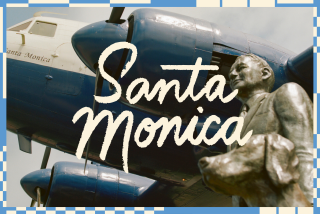An American in Castroâs Cuba
HAVANA â Senorita Anita in the airport takes away the Americanâs passport and hands it to a uniformed, uninformed man who returns it four hours later.
âQue pasa? Donde esta mi pasaporte?â the American inquires, several times, but Senorita Anita shrugs and smiles and says, perhaps before you pass through customs you would care to visit one of Jose Marti Airportâs very fine gift shops. Oh, and welcome to Cuba. . . .
There is a saddle for sale, and a $220 guitar, and a saleswoman tempts the American with some maracas. There are books inside a glass-enclosed case, mainly nonfiction works about Fidel Castro and Nelson Mandela, and Senorita Anita wonders which writers do you like.
Perhaps she will be pleased if the American mentions the island idol Ernest Hemingway, he thinks, so he does, whereupon Senorita Anita nods and says that, personally, she is partial to Ross MacDonald. Cuba. . . .
A green 1955 Chevrolet prowls the premises just beyond the baggage claim, and so does somebody in a straw cowboy hat with âSenor Slickâ stitched on his jacket. As the happy American gets his papers back, he quenches his thirst with a cold bottle of TropiCola, buys a victory cigar the size of a clarinet, lights it and starts singing âFidelâ to the tune of the Beatlesâ âMichelle.â Cuba. . . .
The heat just south of the Tropic of Cancer is intense, but the people are not; they are kind and helpful and cool. There is air-conditioning in the Americanâs hotel room and a working shower in the bathroom and none of the horrors he imagined or was told to expect. Dark clouds materialize above the gulf inlet outside his window; Julia Roberts and Richard Gere materialize on the only operative channel on the TV in his room. Cuba. . . .
Straying on foot into a neighborhood many blocks from the hotel, quite apart from the business district, the American encounters energetic children at play, pitching and hitting a rubber ball, New York style, on the congested walkway. He watches the stickball game and they watch him, curious about a stranger in their midst, until finally they consult with one another, ostensibly to decide what to do about this guy. Then they invite him to play. Cuba. . . .
A seaside drive along El Malecon, sort of the Pacific Coast Highway of Havana, becomes an ever-winding reminder why Christopher Columbus, after docking here in 1492, wrote in his ledger that it was âthe most beautiful land men ever laid their eyes on.â
A semblance of a breeze helps dissipate the puffs of black smoke belching from the buses, and by the castle of the three kings of the Morro, a mighty fortress once cannonaded by nearly 18,000 shells, picture-perfect whitecaps crash onto the rocks. Cuba. . . .
The city streets are like sets from a Universal Studios tour. Antiquated, dilapidated buildings with crumbling columns have been spruced up with a cosmetic make-over of paint in primary colors, like locations from Warren Beattyâs âDick Tracy.â Here comes a gray â47 Plymouth and there goes a Studebaker Lark of indeterminate age, alongside vintage motorcycles with sidecars, lubricated, perhaps, with Castro oil. Cuba. . . .
A cursory examination of facilities built for the coming Pan American Games reveals what can be accomplished with little money and much work. Outside the cycling velodrome are real boulders ornamented with make-believe iguanas or lizards. Inside the track-and-field stadium are young girls rehearsing a kind of âUp With Cuban Peopleâ revue, some of whom would certainly qualify in a year or two for the Tropicanaâs floor show. A salsa beat is the Americanâs accompaniment, pouring from loudspeakers, perpetual Tito Puente, wherever he goes. Cuba. . . .
In the El Prado district, across from the stately Capitolio museum atop which workers sit eating lunch on the treacherous ledge of the dome, there is a boxing arena bearing the name and likeness of Kid Chocolate, who was Eligio Sardinas before he came to 1930s America as a 16-year-old prizefighter, lying about his age, and became a champion dazzling in form and deed.
A young Cuban named Antonio Aguilera Sanchez, guiding an impromptu tour of the gym named for this man he admired so much, says: âKid Chocolate, he stopped traffic in New York when he walked. He was so elegant, by comparison the Duke of Windsor was poorly dressed.â Cuba. . . . Next door, the American checks out a movie marquee, wonders what is playing in downtown Havana these days. âEl Vengadorâ is what is appearing, as is the face of the man who starred in it, Arnold Schwarzenegger, when it was more popularly known as âCommando.â
Oh, and a nearby poster advertises: Ciclo Los Jovenos Actors en el cine Norteamerican conduce: âEl Club del Desayuno,â con Emilio Estevez, Ally Shedy (sic) , Molly Ringwald . The Americanâs Spanish may be rusty, but he does know what a club is and does understand the word meaning breakfast. Cuba. . . .
He takes a last evening stroll. A shop window displays a baseball, a three-foot snake, a model airplane, a baseball bat and a miniature rocket--hand-crafted entirely from tobacco. A billboard advertises âMarina Hemingway,â and he is unsure whether this refers to a fishing resort or to a relative of Margauxâs and Marielâs. A travel poster invites: âVen a vivir una tentacion.â (âCome and Be Tempted.â) He has. He will. Whatever. Cuba. . . .
More to Read
Sign up for The Wild
Weâll help you find the best places to hike, bike and run, as well as the perfect silent spots for meditation and yoga.
You may occasionally receive promotional content from the Los Angeles Times.






